Abstract
Evidence from studies in rodents suggests that mate selection is influenced by major-histocompatibility-complex haplotypes, with preferences for dissimilar partners. This study was initiated to determine whether avoidance of a mate with the same HLA haplotype as one's own might be occurring in the Hutterites, a North American reproductive isolate of European ancestry, notable for their large sibships, communal lifestyle, and limited number of five-locus HLA haplotypes (HLA-A, -B, -C, -DR, and -DQ). HLA haplotypes were known for 411 Hutterite couples. The number of couples expected to match for a haplotype was calculated in two ways: first, from population genotype frequencies, with account being taken of the nonrandom mating pattern with respect to colony lineages, and, second, from computer simulations using conservative founder assumptions and the exact genealogy of the 411 couples. We observed fewer matches for HLA haplotypes between spouses than expected (first method, P = .005; second method, P = .020-.067). Among couples who did match for a haplotype, the matched haplotype was inherited from the mother in 29 cases and from the father in 50 cases (P = .018). These results are consistent with the conclusion that Hutterite mate choice is influenced by HLA haplotypes, with an avoidance of spouses with haplotypes that are the same as one's own.
Full text
PDF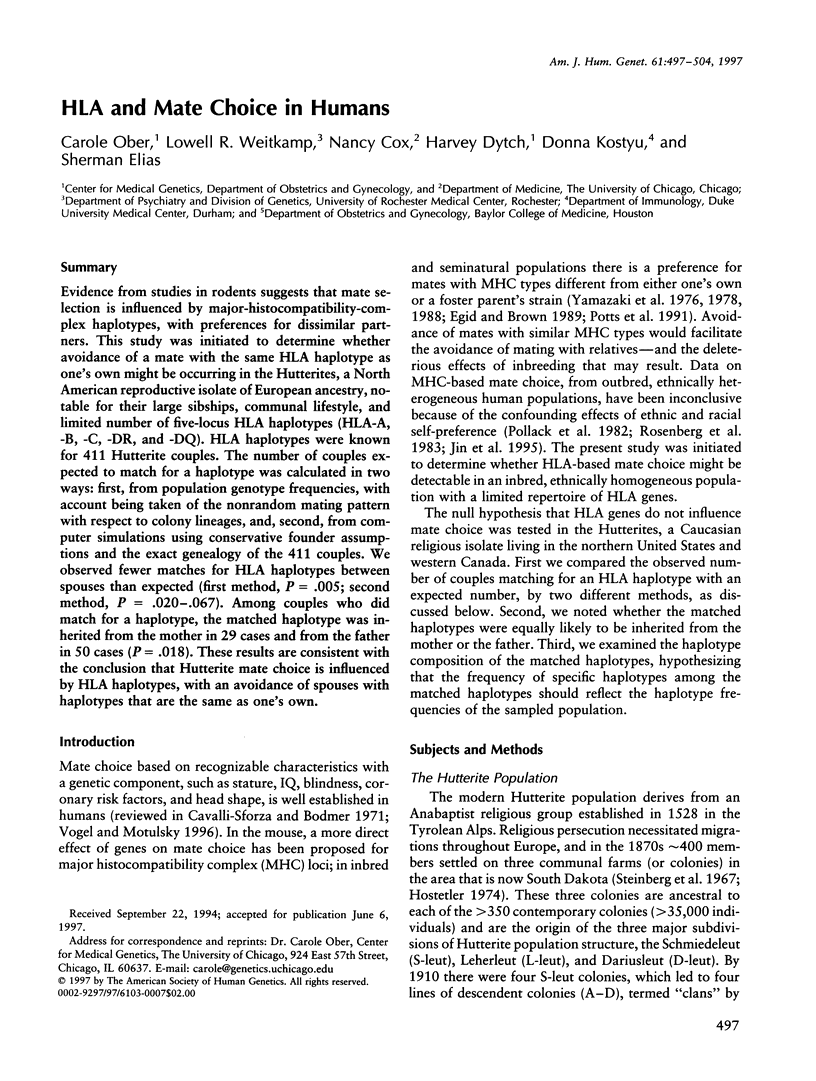

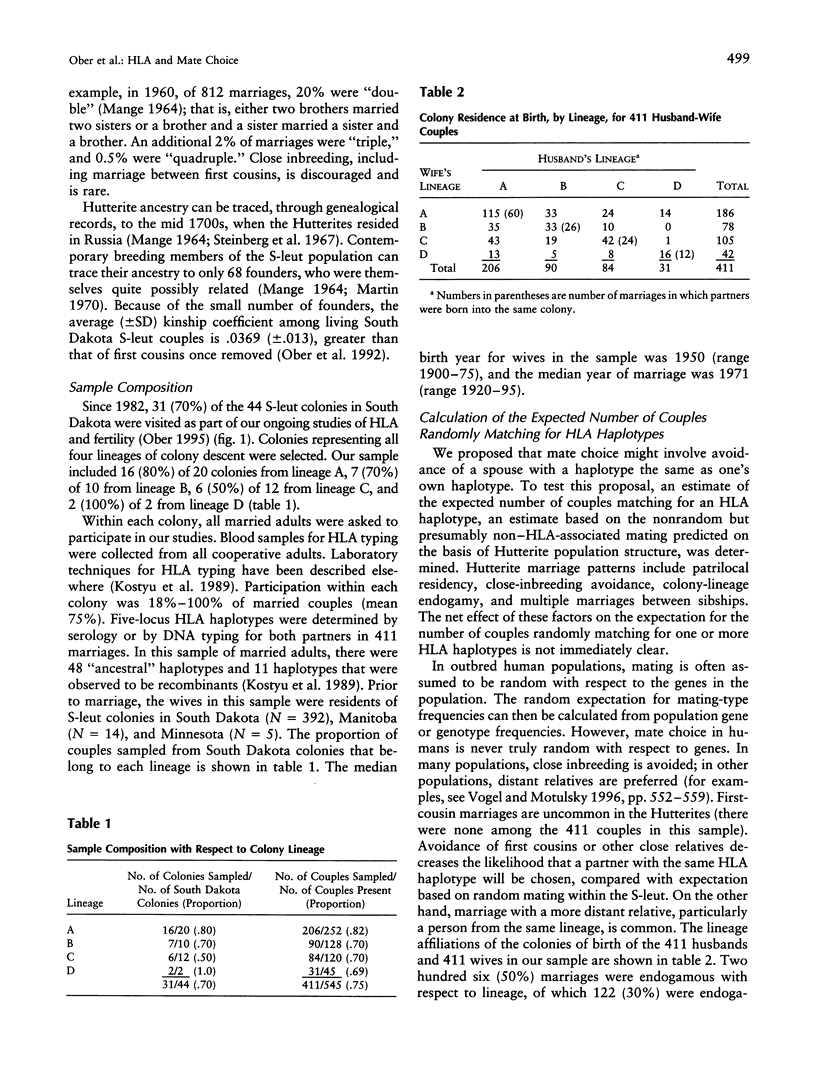
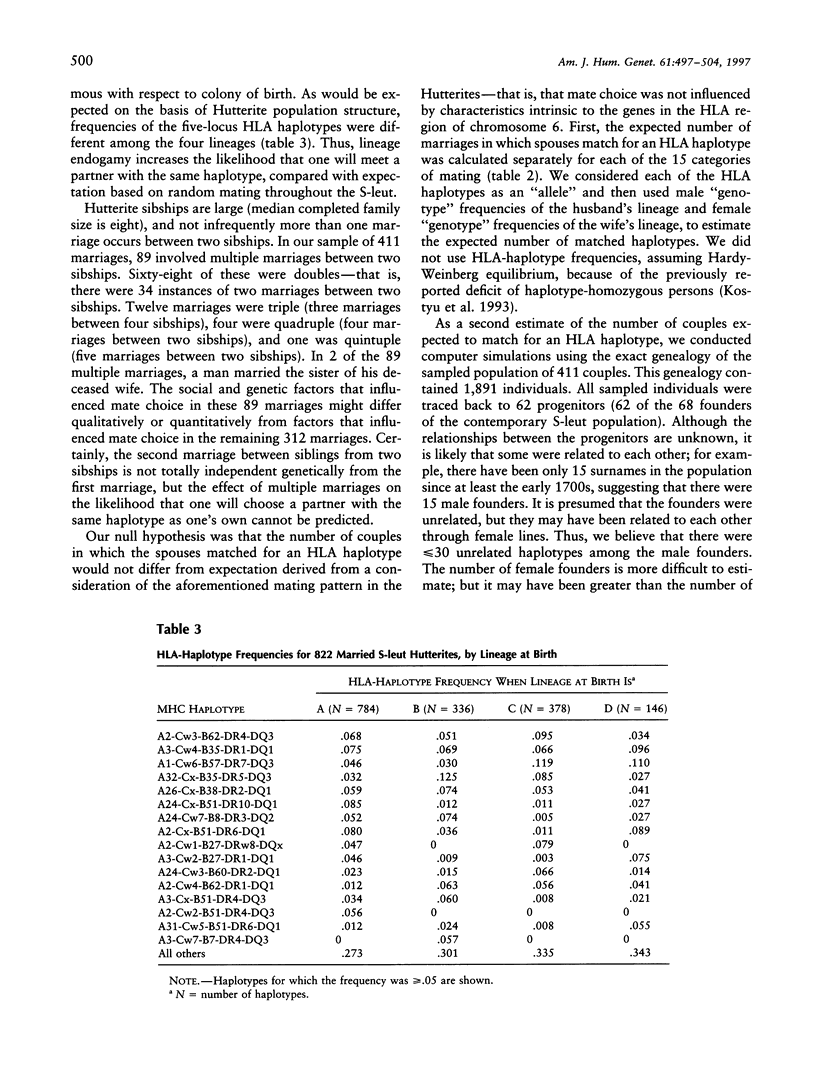

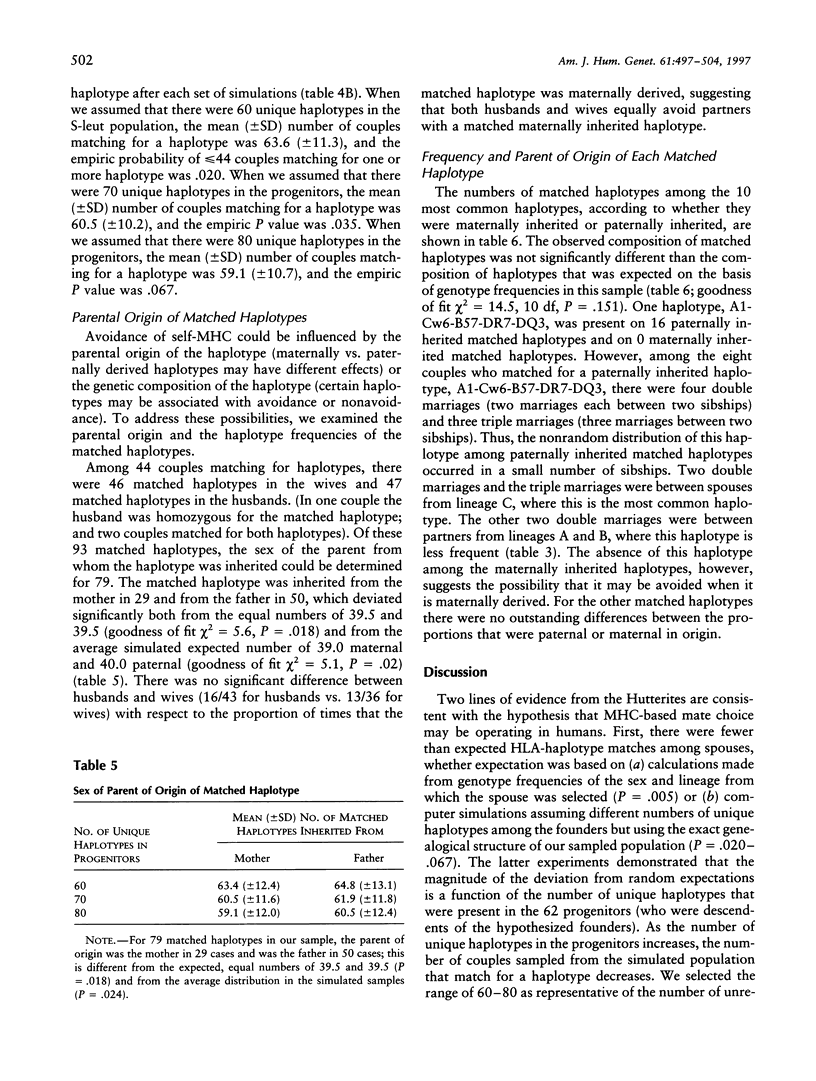
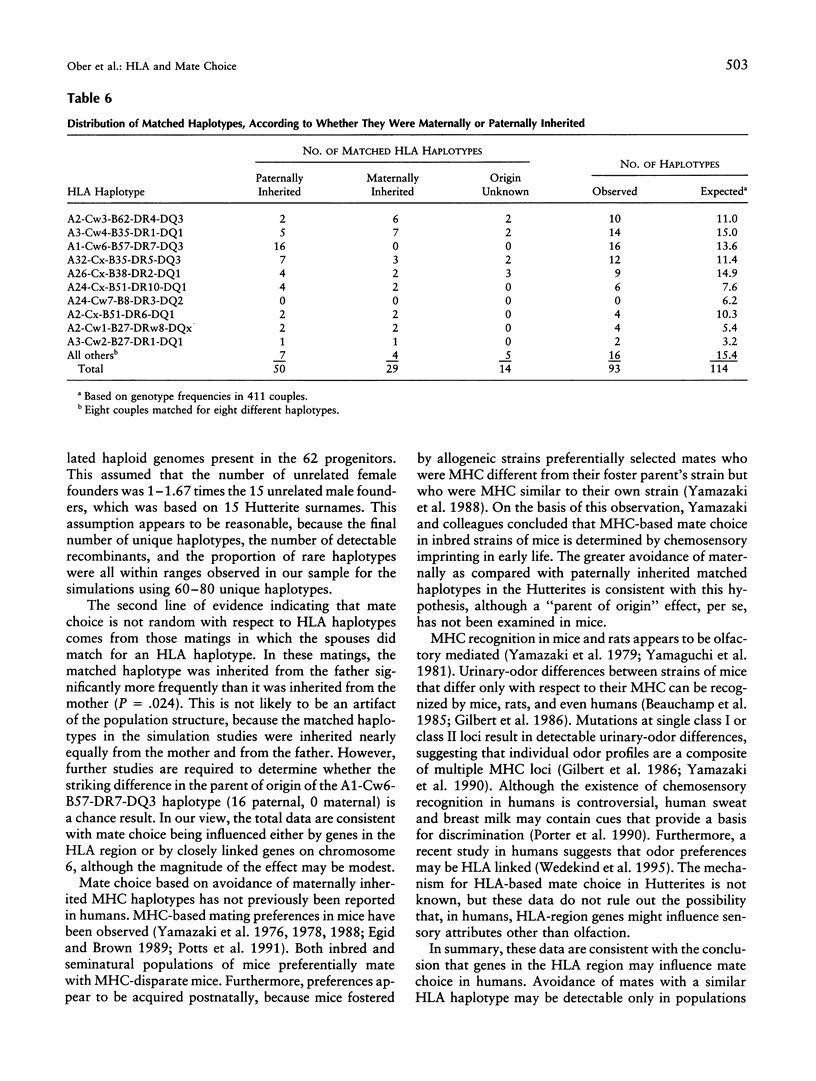
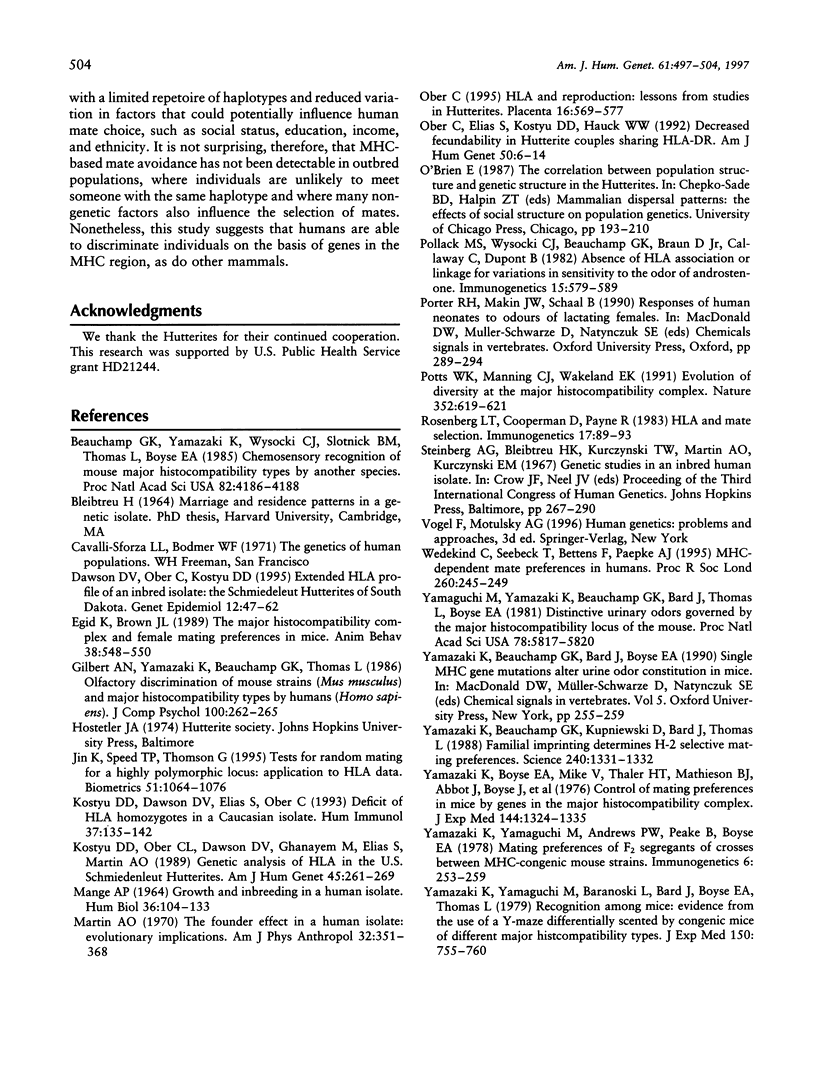
Selected References
These references are in PubMed. This may not be the complete list of references from this article.
- Beauchamp G. K., Yamazaki K., Wysocki C. J., Slotnick B. M., Thomas L., Boyse E. A. Chemosensory recognition of mouse major histocompatibility types by another species. Proc Natl Acad Sci U S A. 1985 Jun;82(12):4186–4188. doi: 10.1073/pnas.82.12.4186. [DOI] [PMC free article] [PubMed] [Google Scholar]
- Gilbert A. N., Yamazaki K., Beauchamp G. K., Thomas L. Olfactory discrimination of mouse strains (Mus musculus) and major histocompatibility types by humans (Homo sapiens). J Comp Psychol. 1986 Sep;100(3):262–265. [PubMed] [Google Scholar]
- Kostyu D. D., Dawson D. V., Elias S., Ober C. Deficit of HLA homozygotes in a Caucasian isolate. Hum Immunol. 1993 Jul;37(3):135–142. doi: 10.1016/0198-8859(93)90178-4. [DOI] [PubMed] [Google Scholar]
- Kostyu D. D., Ober C. L., Dawson D. V., Ghanayem M., Elias S., Martin A. O. Genetic analysis of HLA in the U.S. Schmiedenleut Hutterites. Am J Hum Genet. 1989 Aug;45(2):261–269. [PMC free article] [PubMed] [Google Scholar]
- MANGE A. P. GROWTH AND INBREEDING OF A HUMAN ISOLATE. Hum Biol. 1964 May;36:104–133. [PubMed] [Google Scholar]
- Martin A. O. The founder effect in a human isolate: evolutionary implications. Am J Phys Anthropol. 1970 May;32(3):351–367. doi: 10.1002/ajpa.1330320305. [DOI] [PubMed] [Google Scholar]
- Ober C. Current topic: HLA and reproduction: lessons from studies in the Hutterites. Placenta. 1995 Oct;16(7):569–577. doi: 10.1016/0143-4004(95)90026-8. [DOI] [PubMed] [Google Scholar]
- Ober C., Elias S., Kostyu D. D., Hauck W. W. Decreased fecundability in Hutterite couples sharing HLA-DR. Am J Hum Genet. 1992 Jan;50(1):6–14. [PMC free article] [PubMed] [Google Scholar]
- Pollack M. S., Wysocki C. J., Beauchamp G. K., Braun D., Jr, Callaway C., Dupont B. Absence of HLA association or linkage for variations in sensitivity to the odor of androstenone. Immunogenetics. 1982;15(6):579–589. doi: 10.1007/BF00347052. [DOI] [PubMed] [Google Scholar]
- Potts W. K., Manning C. J., Wakeland E. K. Mating patterns in seminatural populations of mice influenced by MHC genotype. Nature. 1991 Aug 15;352(6336):619–621. doi: 10.1038/352619a0. [DOI] [PubMed] [Google Scholar]
- Rosenberg L. T., Cooperman D., Payne R. HLA and mate selection. Immunogenetics. 1983;17(1):89–93. doi: 10.1007/BF00364292. [DOI] [PubMed] [Google Scholar]
- Wedekind C., Seebeck T., Bettens F., Paepke A. J. MHC-dependent mate preferences in humans. Proc Biol Sci. 1995 Jun 22;260(1359):245–249. doi: 10.1098/rspb.1995.0087. [DOI] [PubMed] [Google Scholar]
- Yamaguchi M., Yamazaki K., Beauchamp G. K., Bard J., Thomas L., Boyse E. A. Distinctive urinary odors governed by the major histocompatibility locus of the mouse. Proc Natl Acad Sci U S A. 1981 Sep;78(9):5817–5820. doi: 10.1073/pnas.78.9.5817. [DOI] [PMC free article] [PubMed] [Google Scholar]
- Yamazaki K., Beauchamp G. K., Kupniewski D., Bard J., Thomas L., Boyse E. A. Familial imprinting determines H-2 selective mating preferences. Science. 1988 Jun 3;240(4857):1331–1332. doi: 10.1126/science.3375818. [DOI] [PubMed] [Google Scholar]
- Yamazaki K., Boyse E. A., Miké V., Thaler H. T., Mathieson B. J., Abbott J., Boyse J., Zayas Z. A., Thomas L. Control of mating preferences in mice by genes in the major histocompatibility complex. J Exp Med. 1976 Nov 2;144(5):1324–1335. doi: 10.1084/jem.144.5.1324. [DOI] [PMC free article] [PubMed] [Google Scholar]
- Yamazaki K., Yamaguchi M., Baranoski L., Bard J., Boyse E. A., Thomas L. Recognition among mice. Evidence from the use of a Y-maze differentially scented by congenic mice of different major histocompatibility types. J Exp Med. 1979 Oct 1;150(4):755–760. doi: 10.1084/jem.150.4.755. [DOI] [PMC free article] [PubMed] [Google Scholar]


